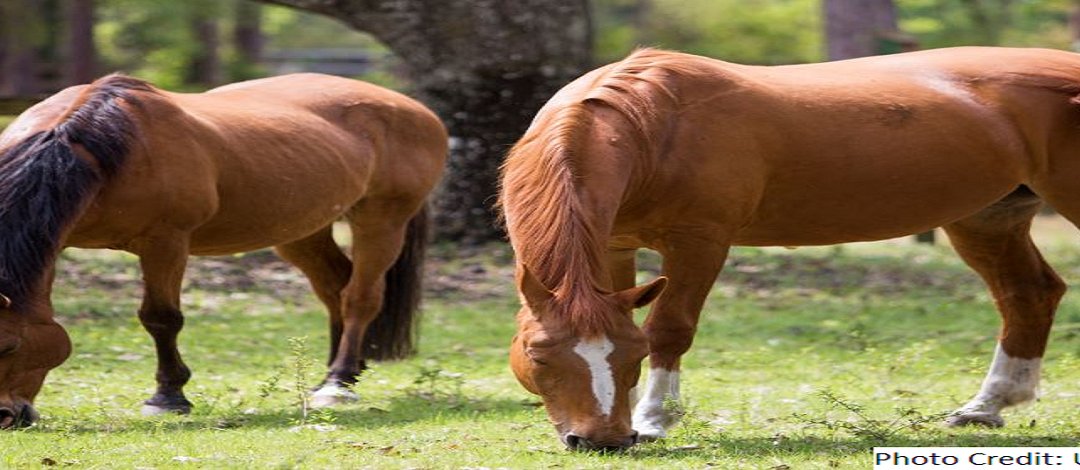
by amgranger | Sep 28, 2018
Be Prepared and Have a Plan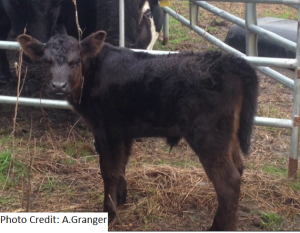
This time last year, we were helping our 4-H friends all over Florida recover from Hurricane Irma. Hurricane season has been quiet in Florida so far, but that doesn’t mean we need to let our guard down – we still have two more months of hurricane season.
So,what would you do if you didn’t have electricity? How will you care for your 4-H project animals? Do you have an evacuation plan? Answers to these questions become major issues when dealing with disasters.
Disasters can be natural/weather-related, man-made or accidental. Regardless of the type, it’s important to be prepared and have a plan for you and your animals.
Plan for Your Animal’s Safety
Whether you evacuate or shelter in place, here are a few considerations:
- Be ready to leave once the evacuation is ordered.
- Evacuate animals as soon as possible.
- Your project animal won’t be able to stay with you in a shelter like a dog or a can.
- Know where safe livestock facilities are in your area or along your evacuation route.
- If you can’t evacuate, decide if you’re keeping animals confined to a barn or turning them out into pastures.
- Barn confinement may become dangerous and take away the animal’s ability to protect themselves.
- Pastures should be at least one acre in size with no potential hazards (barbed wire, power-lines, polls or items that can be picked up by the wind).
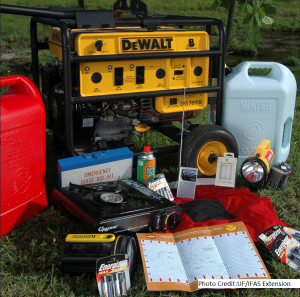 Disaster Preparedness for Livestock – Why Livestock Owners Need to Be Prepared
Disaster Preparedness for Livestock – Why Livestock Owners Need to Be Prepared
The Florida Department of Agriculture and Consumer Services (FDACS) has some suggested guidelines about preparing livestock and horses for disasters:
- Check with your local humane organization, extension office or local emergency management agency to read about your county disaster response plans.
- Determine safe evacuation routes for trailers and livestock.
- Prepare a Farm Disaster Kit and Basic First-Aid Kit. Remember, supplies during or after the disaster may be in short supply, or roadways may be blocked. Keep kits up-to-date, keep them on-site and in your vehicle.
- A vaccination and test records (Coggins, health certificates, etc.)
- A list of all animals, where they are located on the farm and feeding instructions/records
- Sanitation items, cell phone, flashlights, portable radios and batteries.
- Have feed, water, handling equipment, tools, veterinary supplies and a generator (with fuel) on hand if possible.
- Make a list of emergency numbers – veterinarian, neighbors, state veterinarian, animal shelter, county extension office,local volunteer organizations and someone outside of the disaster area.
- Make sure you have proof of animal ownership. Have temporary ID supplies on hand like permanent markers and plastic bands that are safe, durable and visible. ID should include your name, address, and telephone number.
- Poultry need access to high areas to perch if you’re in an area susceptible to flooding. Provide access to clean water and food.
- Remove barbed wire or other fencing so animals can move to areas of safety during flooding or high winds.
- Store water in large containers (enough for a week) suck as troughs, swimming pools or boats
- Secure items that might be picked up and thrown by the wind like pieces of metal, troughs, tanks or trailers.
- Ensure there is safe shelter, fencing or pens.
- Keep animals in groups they’re used to where they are securely contained and protected from the elements.
Resources:
For more information about 4-H, contact your local UF/IFAS County Extension Office. If you are an adult or teen with skills or knowledge you’d like to share, ask about becoming a 4-H volunteer!
by Rachel Pienta | Sep 21, 2018
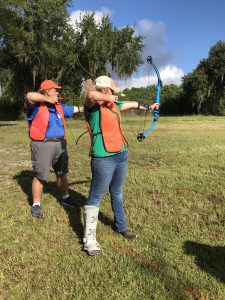
4-H Volunteers learn and practice the archery pre-shot routine so they can teach it to their youth. Photo: Julie P. Dillard
Ready to Lead
Sixteen 4-H volunteers joined ranks with one of Florida 4-H’s largest projects by earning their Level One Shooting Sports Instructor certification September 8. Training participants included 4-H volunteers and UF/IFAS Extension staff from Escambia, Holmes, Jefferson, Marion, Wakulla, Walton, Union and Alachua counties. What sets 4-H instructor training apart from other shooting sports trainings is the focus on youth life skills and positive youth development as opposed to focusing only on skill mastery.
About Florida 4-H Shooting Sports
The 4-H Shooting Sports Program teaches young people safe and responsible use of firearms, principles of archery and hunting basics. Lifelong skill development is one of the main benefits of involvement in the 4-H Shooting Sports Program and applies to both youth and adults involved in the program. Specifically, the 4-H Shooting Sports Program is designed to:
- Provide youth proper training in the use of firearms, archery equipment, and other areas of shooting sports.
- Provide thorough instruction in shooting sports safety.
- Develop life skills such as self-confidence, personal discipline, responsibility, and sportsmanship
- Create an appreciation and understanding of natural resources and their wise use.
- Provide volunteer instructors safe and proper instructional techniques.
- Show volunteer leaders how to plan and manage 4-H Shooting Sports Clubs. (Culen et al, 2018).
Resources for Success
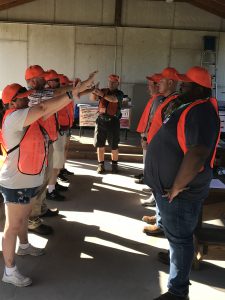
Establishing eye dominance is one of the first tasks of new member. Photo: Julie P. Dillard
It’s important to equip agents, volunteers and youth with the tools they need to succeed in the Florida 4-H Shooting . To assist you in organizing the county shooting sports program, here are some resources from the 4-H State Shooting Sports Committee and Environmental Sciences Action Team:
State Match Information, Rules and Risk Management
Youth Project Books
Getting Organized
To learn more about your county shooting sports program, contact your local 4-H agent.
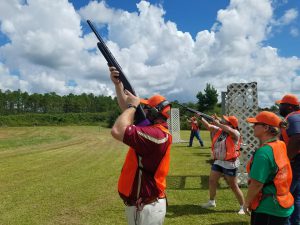
Wakulla 4-H Shooting Sports Club Leader, David Pienta, takes aim during shotgun instruction. Volunteers practice peer teaching to get ready to teach 4-H youth.
by Yolanda Goode | Sep 14, 2018

Gadsden County 4-H youth on campus for 4-H University. 4-HU is the premier youth leadership development event of Florida 4-H.
Leaders – Born or Made?
Many of us have heard the saying, “oh, that young man or woman is such a natural born leader.” But are leaders born that way, or do they develop into leaders? These Gadsden County delegates took advantage of 4-H University this summer – an awesome Florida 4-H state event designed to grow leadership skills. Many of them have also served as volunteer 4-H camp counselors during the summer. They understand that leaders are developed and not born.
What Defines a Leader?
Sometimes people confuse charisma with leadership abilities. Charisma is a special magnetic charm or appeal (Merriam-Webster Dictionary). Many of our local to national leaders have some level of charisma. In addition to charisma, leaders should have the more important skills such as communication, problem solving, critical thinking, managing, and self-awareness. There are many definitions for leadership because there is no universal definition. Leadership involves a process while a leader is the one who carries out the process.
How Does 4-H Unlock Your Leadership Potential?
One of my favorite teaching tools used to develop my Gadsden County 4-H leaders is the “Unlock Your Leadership Potential” by UF/IFAS Extension. It has influenced how I would define a leader. The overall goal of a good leader is to move the group or organization toward its goals while building a sense of togetherness and well-being.
Florida 4-H grows leaders at the club, county, district, and state levels by creating safe and nurturing environments and providing quality experiences. Knowledge and skills are great, but being able to apply them through experience is what fortifies and matures youth as well as increases their confidence. The 4-H slogan, “Learn by Doing”, is why the 4-H Experiential model is important to UF/IFAS-Extension 4-H Youth Development Program. The more active the youth and the duration of a their engagements in 4-H positive youth development the greater the benefits not just for them but also their communities (2013, National 4-H Council). It takes a whole team of Extension professionals, staff, 4-H Seniors, and volunteers to make the “magic” happen.
Call to Action:
- Begin the journey as a youth or volunteer: http://florida4h.org/getinvolved/
- Engage in local and state 4-H programs: http://florida4h.org/programsandevents_/
- Give to Florida 4-H: https://www.uff.ufl.edu/give-now/?fund_id=003603
- Read and share the other great blogs by my colleagues here: https://nwdistrict.ifas.ufl.edu/4hn/
- Join the “30 Days of Doing” 4-H Movement: https://4-h.org/inspire-kids-to-do/
References and Further Reading:
by Jena Gilmore | Sep 7, 2018

It’s that time of year again – Fair Season!
I can just smell the delicious scents of midway foods and see and hear the lights and squeals on carnival rides? But to most 4-H families, fairs go way beyond food and rides. During fair season, youth throughout the state dress up with pride in their 4-H green attire and prepare for what’s to come…fair exhibits!
Fair exhibits can range from artwork to plants to animals and finally, the epic fair booths. The most important thing for youth and adult exhibitors is knowing:
1. What counties are allowed to participate?
2. What and how many categories you may enter?
3. Exhibit requirements.
Here, we’ll cover preparing for fair booths and animal exhibits but you can find multiple links below for the state and local fairs with more information on exhibit entries and requirements.
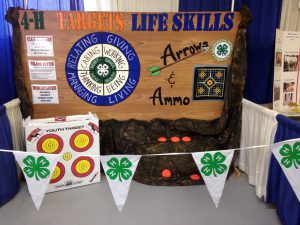
Fair booths are the highlight of displays at the fair
Organizations, like 4-H, use fair booths to visually communicate what we offer. Fair booths can be a great way to create a sense of Belonging in your club by having all members feel like they’re part of the 4-H Family! You want your communication to be effective, so prepare a checklist:
- Research the fair you want to enter – determine the deadline and registration requirements.
- Will you earn a booth premium? If so, figure out how much your club is willing to spend on supplies based on the premium could receive.
- Determine the size of your booth. Going out of booth boundaries can be a point deficit on the scorecard.
- Pick your booth theme and layout.
- Get commitments from members and parents to help with preparation, setup and breakdown. Delegate tasks so everyone feels like they have contributed.
Check out “Exhibits and Displays” below for a full checklist and more information!
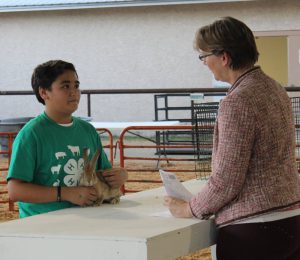
4-H’er talking to the judge of the Rabbit Show at Walton County Fair.
4-H Animal Exhibits
Rabbit, chicken, cattle, swine and goat exhibits are staples of fair week. Animal exhibits give many people the opportunity to see, learn about and interact with animals they don’t normally come across. For our 4-H youth, livestock exhibits and shows give youth the ability to gain Mastery through 4-H Project Learning. These highly experiential experiences teach youth a multitude of life skills. To get your animals fair ready:
- Research the fair’s deadlines and registration. Be sure to check deadlines for acquiring ownership and birth-dates of your animals.
- Check the vaccination and health certificate requirements for your animal and secure an appointment with a veterinarian to have this completed.
- Be on time or early to check-in. Sometimes, there is only one Agriculture Inspector and a long line of exhibitors. Some animals are required to do on-site blood testing, so be prepared with your paperwork and be patient.
- Determine if the fair provides the food and bedding and if exhibitors are required to care for their animals daily. This is not only important for the nutritional well-being of your animal but also for their emotional well-being.
Helpful Links:
Florida Panhandle Fair Opportunities:
- Escambia- Pensacola Interstate Fair (also open to Santa Rosa and Okaloosa counties)
- Okaloosa- Northwest Florida Fair (also open to Escambia and Okaloosa counties)
- Santa Rosa- Santa Rosa County Fair (open to all counties in the Northwest District)
- Walton- Walton County Fair (open to Walton and Okaloosa counties)
- Holmes- Holmes County 4-H Youth Fair
- Washington- Washington County Youth Fair (Beef and swine livestock shows are also open to Holmes and Bay counties)
- Jackson- Panhandle Youth Expo (also open to Walton, Washington, Calhoun, Holmes, Liberty, and Bay counties)
- Bay- Central Panhandle Fair
- Calhoun- no county fair, but eligible to participate in regional and state fairs
- Gulf- no county fair, but eligible to participate in regional and state fairs
- Liberty- no county fair, but eligible to participate in regional and state fairs
- Gadsden- West Florida Livestock Show and Sale (open to counties west of the Suwanee River)
- Franklin- no county fair, but eligible to participate in regional and state fairs
- Wakulla- no county fair, but eligible to participate in regional and state fairs.
- Leon- http://northfloridafair.com/
- Jefferson- no county fair, but eligible to participate in regional and state fairs
If you’re a fair veteran, 4-H alumni, or just someone interested in benefiting the youth of your community, contact your local UF/IFAS County Extension Office to find out how you can become a 4-H Volunteer and share your expertise!

 Disaster Preparedness for Livestock – Why Livestock Owners Need to Be Prepared
Disaster Preparedness for Livestock – Why Livestock Owners Need to Be Prepared







